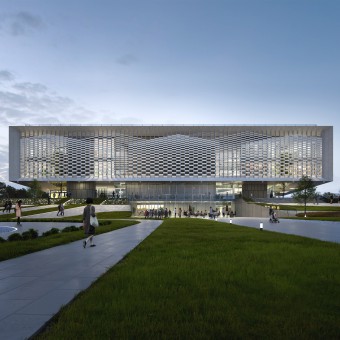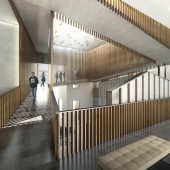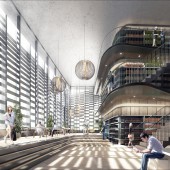
| THE AWARD |
| CATEGORIES |
| REGISTRATION |
| SUBMIT YOUR WORK |
| ENTRY INSTRUCTIONS |
| TERMS & CONDITIONS |
| PUBLICATIONS |
| DATES & FEES |
| METHODOLOGY |
| CONTACT |
| WINNERS |
| PRESS ROOM |
| GET INVOLVED |
| DESIGN PRIZE |
| DESIGN STORE |
| THE AWARD | JURY | CATEGORIES | REGISTRATION | PRESS | WINNERS | PUBLICATIONS | ENTRY INSTRUCTIONS |
Medieval Rethink Cultural Center by QUAD studio |
Home > Winners > Design #98029 >Interview |
 |
|
FS: What is the main principle, idea and inspiration behind your design?
WT: Medieval Rethink was an opportunity to recreate a medieval environment in a contemporary cultural setting. The narrative and design approach of the cultural centre has been extensively explored previously. Located in the norther province of Guangdong, this Contemporary Cultural Centre will not only showcase the history culture of the 900-year-old village, it will also function as a cultural exhibition centre and will attract thousands of visitors from all over the region.
FS: What is the most unique aspect of your design?
WT: The cultural centre becomes the new destination for villagers to congregate and to socially interact. Here, opportunities arise to great a truly cultural contemporary icon inspired by a historical monument that links old and new. We make a focus in the cultural centre. An object that is the primary function, a multipurpose hall that most villagers will congregate in large social events. Other functions are clustered around the object that naturally creates internal streets and courtyards that are filled with an abundance of natural landscape.
FS: Is your design influenced by data or analytical research in any way? What kind of research did you conduct for making this design?
WT: The Setting - Today, the City of Shantou is developing quickly to a megalopolis. With a new Delta City,with its vision to create prime real estate along the coastal waterfront that opens zones for public space and cultural uses.A new city orientated around a series of urban green spaces and canals that creates new neighborhoods with an emphasis on experimental innovation, coastal regeneration and the next generation of agriculture.To the south of Delta city is the village of Zhu Pu in Zhu yuan Residential District that dates to the Song Dynasty with a beautiful concentric medieval planning orientated around an ancient rock formation called the Ding Qi Stone that symbolizes the origin of the village of Zhu Pu. Opportunities - When it comes to the design of the Cultural Centre, we wanted to create a sense of place that the villagers can relate to more as a community centre where villager come and use the space on a day to day basis rather than a civic hall that will only be used on special occasions. This idea changes the look and feel of the cultural centre. The cultural centre becomes the new destination for villagers to congregate and to socially interact. Here, opportunities arise to great a truly cultural contemporary icon inspired by a historical monument that links old and new. A successful example of how a historical monument is interpret into a contemporary icon is the relationship of the Arc de Triomphe and La defense in Paris. The difference here is that we are in just inspired by a monument or the Ding Qi Stone) but also the village that surrounds it. Exploration of the existing village - Walking around the village, we are inspired by the scale and how man and nature exist in harmony. This experience compels us to create a contemporary interpretation of this natural harmony that in turn creates a unique cultural centre for Zhu Pu. A cultural link between the old village and the new cultural centre. Beautifully preserved, the village of Zhu Pu dates to the Song dynasty. With its organic concentric planning, it relates itself to many medieval Chinese urban planning principles. What stands out in the planning of the village is how the residential dwelling and temples sit in harmony with nature.
FS: What are some of the challenges you faced during the design/realization of your concept?
WT: Cultural Differences - The cultural centre was designed for the villagers as their space for social interaction. To design the centre, we had to meet with the villagers and discuss their personal needs for this project. Apart from understanding their culture, the main difficulties come in syphering all their needs and wants information into a design. Only when you understand their culture can you then try to rethink the whole idea of what a cultural centre means to the villager The Abstraction – Abstracting the village into the design took a lot of patience and work so that the final design truly depicts our chosen narrative. By stripping off the facade, we are left with a picture like frame. What this does is it focuses your eye towards the objects within the frame. If we then superimpose an image of this medieval village the frame, what you are left with a framed skyline of the medieval village. Abstraction occurs when the skyline is then pixelated. Using dark and light shades of pixels, we generate an abstraction with a notion of depth. This abstraction creates a shading device and the multi layering of the facade together with the objects inside the cultural centre creates a rich composition depicting a visual depth beyond the facade. Recreating the village – Ultimately, we wanted to create a place that will enhance the lives of the villagers. Creating a narrative for the cultural centre not only help the design collective to create a very special place, it is also an attempt to capture an emotional response for any individual visiting the place. The medieval village has already manifested itself in the planning of the functional objects, the facade and also in the internal public realm.
FS: Thank you for providing us with this opportunity to interview you.
A' Design Award and Competitions grants rights to press members and bloggers to use parts of this interview. This interview is provided as it is; DesignPRWire and A' Design Award and Competitions cannot be held responsible for the answers given by participating designers.
| SOCIAL |
| + Add to Likes / Favorites | Send to My Email | Comment | View Press-Release | Translations |





